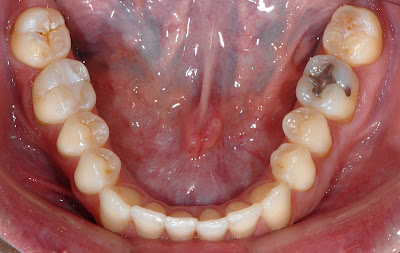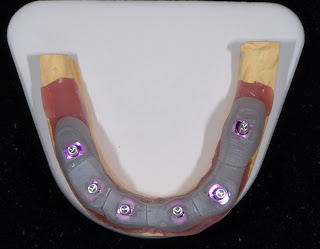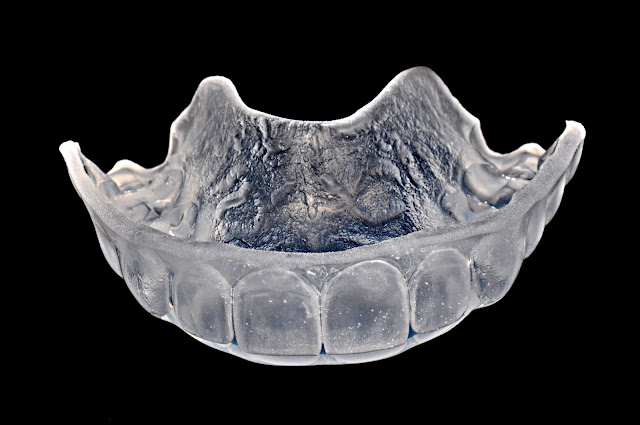Hi! If you're here, it means that you're trying to learn more about clinical photography and the equipment that goes with it. Kudos for taking the first step. Taking GREAT images (not just mediocre ones) is the first step towards changing your practice quality forever.
 |
| There's no reason to shoot a mediocre image (left) when you can quickly and easily learn how to get an awesome lateral image (right). Check out our DVD and get images like the right one for increased case acceptance and better documentation. |
Also, please look to the right and notice our "
Exceptional Clinical Photography Made Easy" DVD for purchase. We're proud that it has been acclaimed as being the best DVD for composition ever made and it's "sister" DVD "Getting Started With Clinical Photography" will be available soon. Don't fret, though, because the
first DVD covers all of the tricks and tips to get exceptional composition every time. Click on the picture and use the code "Blog10" to get 10% off the DVD and any of our custom mirrors and retractors.
So, what camera equipment should I buy?
No matter where I go, or whatever group I speak to, this is by far the most common question I get. After all, what is a dental photography "expert" for if not to be a resource for the most up to date dental gear. So, I figured that this would be a great time to post my thoughts on current equipment.
Please keep in mind (or see my last post) about the fact that almost any equipment can be used to get great dental images. It just comes down to the question of how much work do you want to put into getting your images and how many steps do you want to take to get the kind of quality that facilitates increased case acceptance. After all, we MUST have increased case acceptance if we're going to do this, but more on this in future posts...
Also, keep in mind that if you're going to shoot an SLR (which are by far the easier cameras to use for dental photography once you know how) you MUST learn how to manipulate f-stops and flash settings (keep an eye out for our upcoming DVD "
Getting Started With Clinical Photography" due out around 8/1/12), but as any of my students can tell you, those are two REALLY easy things to do once you're properly shown how. Though virtually no point and shoot will allow you to manually adjust f-stops or flash settings, the major differences in SLRs brands is the steps you need to take to change those things.
Now, for whatever reason,
Canon definitely owns market share in dentistry. No matter what group I am speaking to, roughly 80% of dentists with SLRs seem to using
Canons. That's OK. The only hurdle is that
Nikon has always been ahead of Canon when it comes to the steps necessary to do what we need to do in dentistry. For instance, to change flash settings on the Nikon flash, one need only turn a dial one click and you're done. On Canon, you need to push the mode button, then select, then + or - an appropriate amount of times, then do it in reverse when you want to return to the original settings. For years, on Canon models, in order to see the histogram (the Almighty's gift to digital dental photographers) one needed to hit the play button, then info and wait for the tiny histogram, while at the same time Nikon models showed the histogram as an overlay that was full size. It was "little" things like this that always irked me with Canon. Are they great cameras? Definitely. Would I buy one for dentistry right now? No. Only because of what I just talked about. There's one more major reason...
 Nikon
Nikon has the
R1 flash (see right). Yes, it kind of looks like a Klingon bird of prey, but trust me on this. Learn how to effectively use this flash and your images will be exceptional. You see, the flashes are wide which gives you great shadows. Why do we like shadows? They give us ideal surface texture, embrasures and nuances of what we're shooting. Wanna destroy all of that? Use a ring flash. However, if you've learned how to use retractors and mirrors properly, this flash is a breeze to use. Like I said, switching from say a 1/4 flash setting to a full flash (for intraoral versus full face images) is a less than 1 second process. Plus, the flash is wireless, which gets rid of all of thos annoying cords. The angle of the flash is adjustable as well. I could go on and on about why a wireless flash could be useful from full face portraits to shooting lab work in a digital lightbox.
 |
| Canon MT 24EX |
|
 |
| Canon MR 14EX TTL (Double point, not ring) |
|
|
|
Canon has two particular types of flashes that work great (see right) but they really aren't that close to the R1. They make a dual twin flash that looks like the R1 but has tons of buttons and wires and once set up, is far more complicated to use than the R1. They also have the traditional double point flash that works nicely, but again, a lot of buttons, and the flash is very close to the lens which means less shadows, which means less emphasis and highlights. People think it's a ring flash, but it actually is a double point flash, however for some of our portraits, in order to get rid of annoying shadows, we need to turn off one flash. It's really easy with the R1, but with either of these flashes (or a Sigma equivalent) you'll be hitting so many buttons that you'll like a middle school girl texting her BFF. Of course, you could adapt the R1 to your Canon, but you would need the
R1C1 which includes the commander module to make them fire, which increases the size and the price by $250. For that price, I'd stay with the conventional Canon choices.
Lenses
In this category, again, for dental use,
Nikon comes out on top in terms of choices and versatility. As a side note, I never recommend using any "glass" (aka lens) other than what the manufacturer made. I have nothing against 3rd party lenses, but as dentists, we want as little muss and fuss when something goes wrong, and if my camera isn't working properly, I want to hand everything over to them and say "It's all your equipment. Fix it.". We don't need the camera manufacturer blaming the lens and vice versa.
The old standby for Nikon was the
Nikkor 105mm "micro" (only Nikkor uses the term "micro" instead of macro) and the new lens is beautiful, but it costs nearly $950 and is pretty heavy and wide. I'd suggest the
85mm lens which is way smaller, lighter and about $450 less!!! (See below)
 |
| Nikkor 105mm vs 85mm "micro" lenses |
The biggest complaint that most non-dental photographers have is that the lens is too light and feels flimsy, but I can tell you that lecturing all over the US every year and having to lug my "loaner" equipment for my courses, I have never encountered a problem with this lens and I can see no difference between it and the 105mm in terms of quality (see below).
 |
| Nikkor 105 vs 85 on same patient (unretouched) |
Unfortunately, Canon offers the standard
100mm lens which is of slightly lesser quality than the Nikon 105mm but you'll never know the difference. Canon does make a
second 100mm lens for a price of about $1100 but we just don't need it for dentistry. The next smaller/lighter lens is the
60mm, but it does change where you have to stand when you shoot images for patients and may bring you a little closer to the patient than you want to be. Remember, you cannot use a lens from one manufacturer with another.
Cameras
Ok, here is the part you've been waiting for, right? By now, you know what you're locked into a flash and lens depending on the brand, so you have to choose. The price and features of both the Nikon and Canon are almost identical, regardless of which model you want. The only exception is the
D90 by Nikon (if you can still find one). If one can still get the
D90, which is no longer made, but is a great camera, you can get the lens, flash and body for less than $1900 and there is no comparable Canon setup at that price. If you can't get the D90, the next camera to get in the Nikon family is the
D7000. There is no reason to go more expensive unless you like to waste money. It gives you nothing! Do not be tempted to go down to the
D5100 either. It does not have commander mode for the R1, so to use the flash you must buy the R1C1 (like a Canon) and you just raised the price by $250.
Canon has some great cameras, but the best one right now is the
60D. It is more than enough camera to do anything you need. I would not suggest jumping up to the 70D when it comes out while the 60D is availale. Remember, we don't need many of the features that these cameras perform. All we need is a light, small camera body that can shoot aperture priority and take the lenses and flashes that we want. The Rebel T2i is a great camera and less expensive, lighter and smaller than a 60D. My only complaint is that the Rebel series (and the Nikon 5100) is and has always been a "consumer" camera. It's less expensive than "prosumer" cameras like the D90, D7000 and 60D which are made more rugged and are meant to last longer and take a bit more of a beating. The way I look at it, this is a commercial application, not a personal application, so why go with a consumer camera. If your budget absolutely doe NOT include a prosumer body, and you want Canon, then go with the Rebel series and maybe upgrade the body at some later date. The lens and flash will fit onto your future camera.
If you do not already own a dental camera but are considering buying one, I would encourage you to attend one of my courses where you'll get to try my loaner equipment before you buy, and at the same time, get personal instruction from me. If you can't make it to my course, at least consider my DVD for exceptional composition available
HERE. Also remember that my specialized line of mirrors and retractors is available only through my website, and were developed by me after watching thousands of students use conventional mirror designs. I have been told that they make a huge difference and I would invite you to give them a shot. I offer "starter" sets of mirrors and retractors with and without the DVD, and they can be seen by clicking
Here.
Well, I hope this helped. PLEASE, PLEASE, PLEASE REMEMBER: It's not about the camera. Please see my previous post to understand why. In the end, you MUST get properly trained. Great images, used properly in the "digital co-diagnosed" process will help your communication go through the ceiling and help your case acceptance skyrocket, but it DOES NOT happen by accident.
Please e-mail me
Here with any comments or feedback.
Best Wishes,
Glenn


















































